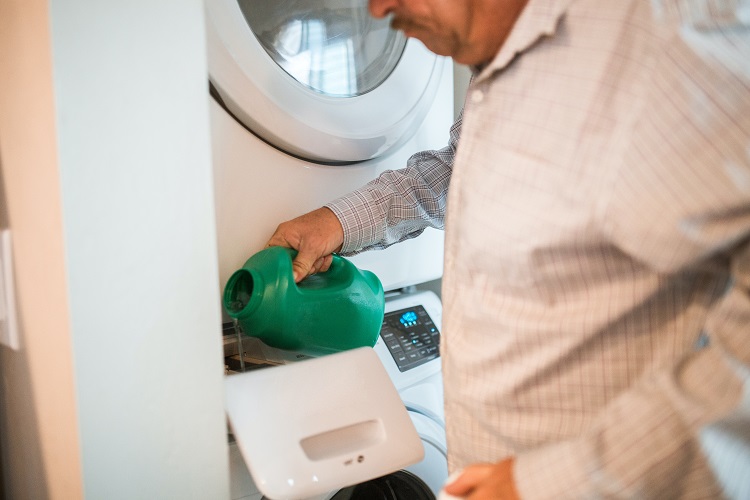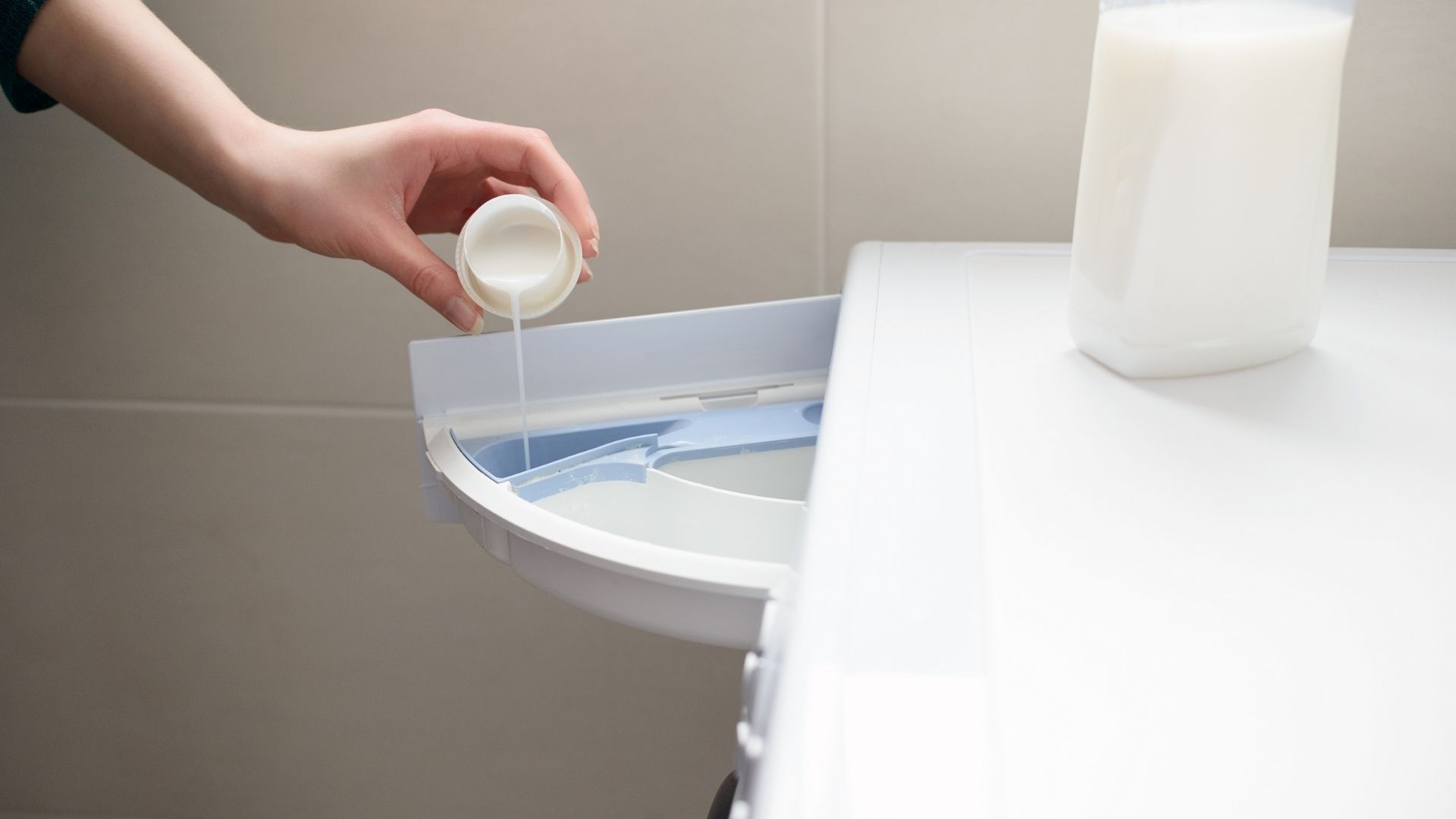General info
The bleach dispenser contains a bleach and water mixture. It contains between 6% and 12% sodium hypochlorite, which is chlorine bleach.
What affects bleaching? Bleaching results are affected by many factors including bleach concentration (if it's diluted more it will be less effective), water temperature, washing machine agitation speed, and type of fabric.
Bleach also loses its effectiveness over time so you should always check whether you have enough before applying, or just add some extra if needed. And never mix bleaching products with other household cleaning chemicals because they will react with each other to produce dangerous fumes.
A fabric softener works by coating and protecting the fibers in your clothes. There is no set formulation for fabric softeners, and their formulations and ingredients vary between manufacturers and types (liquid vs dryer sheets). There is generally some combination of chemicals with fragrance and softening agents. These include fatty acid soaps, ethoxylated polyethylene or ethylene glycol esters, quaternary amines, betaine surfactants, amidoamine surfactants, amine oxides, and imidazoline compounds.
When do you need to use a bleach dispenser?
Fabric softener works by coating the fibers in your clothes. The sodium hypochlorite (bleach) and water mixture in a bleach dispenser cancel out the effects of the fabric softener. If you put any amount of fabric softener into a bleach dispenser, it will be ineffective at removing stains and cleaning your clothing.
If you're using bleach to clean toilets or other surfaces that should not come into contact with fabric softeners, be sure to add it before adding other ingredients such as soap or detergents.
To add chlorine bleach: close lid securely and shake the container so the solution is mixed evenly; remove the cap and pour liquid directly on stained areas; clean sponge/brush while wearing gloves for added protection; wipe away stains starting from the outside of the stain and work toward the middle.
When do you not need to use a bleach dispenser?
You don't need to use a bleach dispenser if you're using chlorine bleach for other purposes, such as cleaning surfaces that will come into contact with fabric softener or removing stains on fabrics that are safe for both fabrics softener and bleach. You also would not need to use it in addition to laundry detergent or soap while handwashing clothing.
Bleach dispensers are necessary only when using chlorine bleach (such as Clorox) mixed with water to clean high-protein-stain materials like grass, blood, eggs, cheese and dirt while avoiding damage caused by softeners.
How does a fabric softener work in a HE washing machine?
Fabric softeners work by coating fibers in your clothes to create a temporary barrier that reduces stiffness and static. Fabric softeners are added to the wash cycle but not detergent, which means you can't judge how much soap is in your laundry just by its feel.
Unfortunately, we do not know if fabric softeners interact with bleach or dye - either way, we recommend testing any combination of these products on a small portion of fabric before adding them to your entire load.

Can I use fabric softener in the bleach dispenser?
No. a Fabric softener is not a detergent and will not be able to remove or prevent buildup from causing issues with the machine's operation. Using fabric softener in the bleach dispenser can cause problems such as:
- it will make your fabrics feel softer for a short period of time but reduce their durability
- it will leave a waxy build upon the machine's dispenser
- the fabric softener will decrease oxygen bleach performance, which means your whites won't stay as white for as long
When you put fabric softener in the bleach dispenser it can release chlorine gas into the air. A release of chlorine gas can irritate your eyes and respiratory system, resulting in coughing, a sore throat, nausea, asthma attacks, and chest pain. When you put fabric softener in the bleach dispenser it can make build-up more difficult to remove from your machine.
Moreover, chlorine gas is a quite poisonous gas, that can cause harm to any living tissue. When chlorine gas is inhaled it can irritate the lungs and airways, which leads to wheezing, coughing, shortness of breath, and pain in your chest.
What can you use instead of fabric softener?
- Use a laundry solution such as Oxyclean in the bleach dispenser.
- Add a cup of white vinegar to a rinse cycle when washing whites only.
- Wash clothes in hot water with detergent and use oxy-boosting detergents when washing colored clothes with colorfast dyes.
Do not overload your machine, this causes less agitation and promotes better cleaning. You can add more than one item at once by stacking them evenly on top of each other so they do not tumble around and leave residue behind. Wipe out the detergent dispenser with a mixture of baking soda and water, if it is built up clean it with an old brush or similar scrubber.
All the fabric softener alternatives are also really good at making your clothes smell nice. You can add a few drops of essential oil to a cup of baking soda and sprinkle it in the drum, or put a potpourri bowl inside your washing machine when you do a load.
When using any alternative to fabric softener keep in mind that none remove stains as good as conventional products, but they can work on very light stains. When using an alternative to fabric softener, always remember that the color of the clothes will fade faster and whites may not stay as white as long as with a conventional product.
How can you use fabric softener without a bleach dispenser?
Fabric softeners are designed to make your clothes feel softer, reduce static cling and help your clothes release wrinkles easier.
Put one tablespoon of fabric softener in the empty dispenser. Then add 1/2 cup vinegar to the bleach dispenser. Run a whitewash using warm or hot water. Don't use detergent but do not be afraid that your clothing will not get clean - it should come out clean without soap even though you haven't used any soap!
If you still want to use soap then we suggest using Boost Oxygen Bleach Detergent because it contains oxygen bleach which means that it can remove stains better than detergents that don't contain this ingredient.
If you have an HE washing machine, remember never to put vinegar in the bleach dispenser.
What are the alternative variants for bleach dispensers?
Bleach is a very effective cleaning agent which is often used in the toilet and kitchen because it kills bacteria and can remove stains. Bleach has a very high concentration of sodium hypochlorite and comes in different concentrations for different purposes, such as laundry bleach (sodium hypochlorite), disinfectant bleach (sodium hypochlorite), and many different household bleaches (many other chemicals).
Using bleach can be quite dangerous to your health if not handled properly. When you are doing the laundry with bleach you should never pour bleach on top of your clothes or any article that can stain easily. You should always dilute bleach before application, just remember that every time you use some extra amount of water then your clothes will take longer to dry.

So how can you use bleach without a bleach dispenser?
Softener balls:
This is perhaps the easiest method. You will need softener balls (which are freely available in supermarkets or online), which help separate your clothes and make them softer, similar to fabric softeners. Add two softener balls to the washing machine drum before adding your laundry.
Dryer sheets:
You can also use dryer sheets (which you can get for free from laundry and cleaning services or supermarkets) and add one sheet to your washing machine drum before adding clothes. The sheets will stick to the clothes while they are being washed, so when the cycle is over you should remove them.
Use a rag:
You could use a rag, and tie it to the washing machine door so that the rag is hanging outside of the drum. Then close the door and start your wash as usual. The rag will stick to your clothes during washing and you should remove it after washing is finished.
Mixing vinegar:
Using vinegar as an alternative for bleach is perhaps one of the easiest methods if you don't mind giving up some freshness to your fabrics. Pour half a cup of vinegar into the empty bleach dispenser before filling with water and start an ordinary whitewash cycle which doesn't include any detergent but does include fabric softener (you can add 1 tablespoon fabric softener to enable this feature). Like all other alternatives, using vinegar instead of bleach may not result in bleach-like results, but it can still remove stains.
Using hydrogen peroxide:
You can also use hydrogen peroxide instead of bleach. Hydrogen peroxide is often considered better than chlorine bleach because it's more environmentally friendly, hypoallergenic, and less toxic. The downside to using hydrogen peroxide is that you will need to be patient if you want your laundry looking super clean because the process takes longer than with chlorine bleach (about 30 minutes).
But this method does not affect the color of your clothing like other alternatives mentioned previously. It doesn't damage fabrics or cause clothes to fade faster so it might be a good idea to substitute half the amount of your regular detergent for hydrogen peroxide.
Products to use if your washing machine doesn`t have a fabric softener compartment
Sometimes you come across washing machines that don't have a fabric softener compartment. The best alternative for this is to use liquid fabric softener instead of dryer sheets since it's less expensive and the bottle lasts much longer.
Add half a capful (about 20ml) to the detergent dispenser drawer before adding clothes. You can also add vinegar - about 1 tablespoon- into the fabric softener compartment before adding clothes into the drum if your washing machine has one.
What method is the most effective?
It depends on the number of stains you need to remove and how much bleach is necessary before the fabric is bleached. If your fabrics are heavily stained, then vinegar can be the best choice because it's still effective but doesn't cause damage like chlorine bleach does. If there isn't much dirt you can use peroxide or softener balls. And if you want freshness for your clothes between washes use dryer sheets or rags.
What variant is the best for baby skin?
If you want to wash baby clothing or bedding then always use natural products without any chemicals. Vinegar, salt and baking soda are the best choices for baby skin because they're all-natural.
However, if we are speaking about the acidity of the solution, then vinegar is definitely the most acidic.
What is the best choice for allergies?
Hydrogen peroxide is the best variant if you are allergic to any chemicals or detergents. It's completely natural, hypoallergenic, and without any reactions on your skin. However, it can be a little expensive when in contact with bleaching agents that contain chlorine or peroxide.
Another option would be to use a salt-water solution for washing babies' clothes because it`s also very effective and even better than vinegar in removing stains but it doesn't have any bleaching properties itself.
Final words
Putting fabric softener in the bleach dispenser is never a good idea. It can be corrosive to the interior of your washer, discoloring any metal parts, and it doesn't produce reliable results for cleaning stains. The best option would be to use hydrogen peroxide or vinegar for removing stains but if you are allergic then natural products should be used.
Whitewash cycle without detergent + 1 tablespoon fabric softener before adding clothes - not as effective as other methods, but very safe.